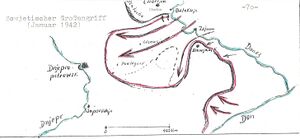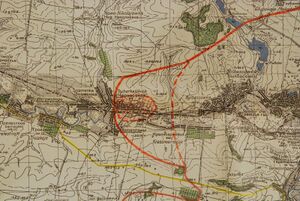11. März 1942
| GEO & MIL INFO | ||||
|---|---|---|---|---|
| Andrejewka | ||||
| Krassnoarmeisk | ||||
| Sowchose No. 5/Kolchos 5/Shabelkivka | ||||
| with 8./477 again, but not as a platoon leader BnCdr II/477: Klaar[1] | ||||
The Bolshevik winter offensive achieved considerable success. Already at the end of January[2] Russian troops had crossed the Donets at Isjum and advanced to Barvenkovo and beyond. Now strong Soviet formations have extended this incursion. They have broken through the German front between Kharkov and Slavyansk over a width of 85 kilometres and have already advanced 100 kilometres deep into our hinterland. In the process, the Soviet fronts have pushed almost to the outskirts of Slavyansk. Our rear connections, already threatened several times, have now been interrupted several times. At the same time, the Reds have succeeded in breaking through our positions on the Donets in many places and encircling some villages. In the east, the front is in places only two kilometres away from the edge of the city. In the north, it runs along a ridge from which one can overlook the entire city.
Slavyansk is encircled on three sides. Soviet batteries are already firing into the city. But Slavyansk is the southern cornerstone of the German front, like Kharkov in the north. If Slavyansk falls, the front will collapse across the board. The city must therefore be held. It is declared a fortress,[3] receives heavy artillery and further troop reinforcements. There are now 21 batteries of all calibres in the city, and their barrels point in all directions, like the spikes of a hedgehog.
11 Mar 1942. My battalion, previously stationed at Rai Gorodok, is also relieved and transferred to Slavyansk for reinforcement.[4] This also ends my duties as liaison officer, and I return to the battalion. First, however, I go to the train to complete my equipment.Then I say goodbye to Fritz and go to the 8th/477th. The company is located on the southwestern outskirts of the city in a small village[5], which is separated from the city only by a meadow about a kilometre wide, a creek bottom. Here we wait for a new deployment. The civilian population is friendly.
Jablonski, the horseman and current chief of the 8th Company, is not at all thrilled about my appearance. He doesn’t have a platoon leader position available at the moment, and he would certainly have preferred to get rid of me altogether. But I’m back now, and I’ll stay here longer than he will.
Here we go again. Our battalion gets ready for action.
About three kilometres west of our hamlet, separated by a stream bottom, lies the village Krassnoarmeisk. It is a long street village, like a long sausage cut in two by the front. The part held by us is at the moment still occupied by a worn-out Austrian unit[6], which we are to relieve.
At the front, the battle rages for the rest of the part of the village we still hold. Krassnoarmeisk is the last bastion before Slavyansk, the gateway to the city. The Soviets have already occupied most of the village. Only the part of the village that pushes forward like a finger on the road to Slavyansk is still in our hands. It is a road about a kilometre long, with a row of houses on each side. And across this road runs the front.
In non-stop, fierce attacks, the Soviets are trying to get hold of this last part of the village. They have the advantage that their observation posts on the heights can see the whole valley and the village, observe every movement and fire immediately.
Over on the left, however, on the heights far behind the front, lies a collective farm[7]. Something is brewing. For days now, you can see isolated figures walking back and forth between the collective farm and the Russian-occupied part of the village.[8] Small dark lines on the white snow. In the glass you can see their earth-brown coats fluttering and the earflaps of their fur hats bobbing up and down. They walk singly or in pairs at long intervals. Now and then one of them goes back. All very inconspicuous. Always just a few men. For many days. If you counted them, you could see that over time more went in than came out of the collective farm. And they were counted, namely by our artillery observers. When I once asked the officer of the observation post to fire a sudden concentration at the red positions on the village road, he said that the collective farm was more dangerous. In fact, our artillery has been firing harassing fire at the collective farm for two days now, and they knew why.
|
Editorial 1938 1939 1940 1941 1942 1943 1944 1945 1946 1947 1948 1949 Epilog Anhang |
|
January February March April May June July August September October November December Eine Art Bilanz Gedankensplitter und Betrachtungen Personen Orte Abkürzungen Stichwort-Index Organigramme Literatur Galerie:Fotos,Karten,Dokumente |
|
1. 2. 3. 4. 5. 6. 7. 8. 9. 10. 11. 12. 13. 14. 15. 16. 17. 18. 19. 20. 21. 22. 23. 24. 25. 26. 27. 28. 29. 30. 31. Erfahrungen i.d.Gefangenschaft Bemerkungen z.russ.Mentalität Träume i.d.Gefangenschaft Personen-Index Namen,Anschriften Personal I.R.477 1940–44 Übersichtskarte (Orte,Wege) Orts-Index Vormarsch-Weg Codenamen der Operationen im Sommer 1942 Mil.Rangordnung 257.Inf.Div. MG-Komp.eines Inf.Batl. Kgf.-Lagerorganisation Kriegstagebücher Allgemeines Zu einzelnen Zeitabschnitten Linkliste Rotkreuzkarte Originalmanuskript Briefe von Kompanie-Angehörigen |
- ↑ fallen in May 1942 (Benary p. 210), unit called “Bataillon Klaar”
- ↑ in the original erroneously “before Christmas”, but there was no attack on Barvenkovo before 18.01.1942
- ↑ cf. remark GenOb Hoth on 12 Apr 1942 (KTB 257. I.D., NARA T-315 Roll 1804 Frame 000851)
- ↑ KTB 257th I.D., NARA T-315 Roll 1805 Frame 000509, Roll 1804 Frame 000817
- ↑ presumably Andreyevka, to where the battalion was transferred in the night 10/11 March (Frame 000817/19)
- ↑ According to the situation map they were soldiers of the 101st light I.D., according to Benary (p. 80) its I.R. 228, since January 1942 subordinated to the 257th I.D., according to KTB 257th I.D. possibly the 68th I.D. (Roll 1804 Frame 000821), which however originated from Guben on the Neisse and had nothing Austrian about it, but rather the I./I.R. 229 to be relieved by II./477 (Roll 1805 Frame 000512). Although the 101st le.I.D. had been formed in the military district of Bohemia and Moravia, it belonged to the south-west German military district V; some Austrians or Bohemians could therefore still have been among them. There is a photo which is meant to prove that Gebirgsjäger have been in Sloviansk.
- ↑ on the Map Russia 1:100,000 Sheet M-37 111-112 "Sowchose No. 5", in KTB 257. I.D. "Kolchos 5"; today the place is called Shabelkiwka
- ↑ KTB 257. I.D., NARA T-315 Roll 1805 Frame 000520


